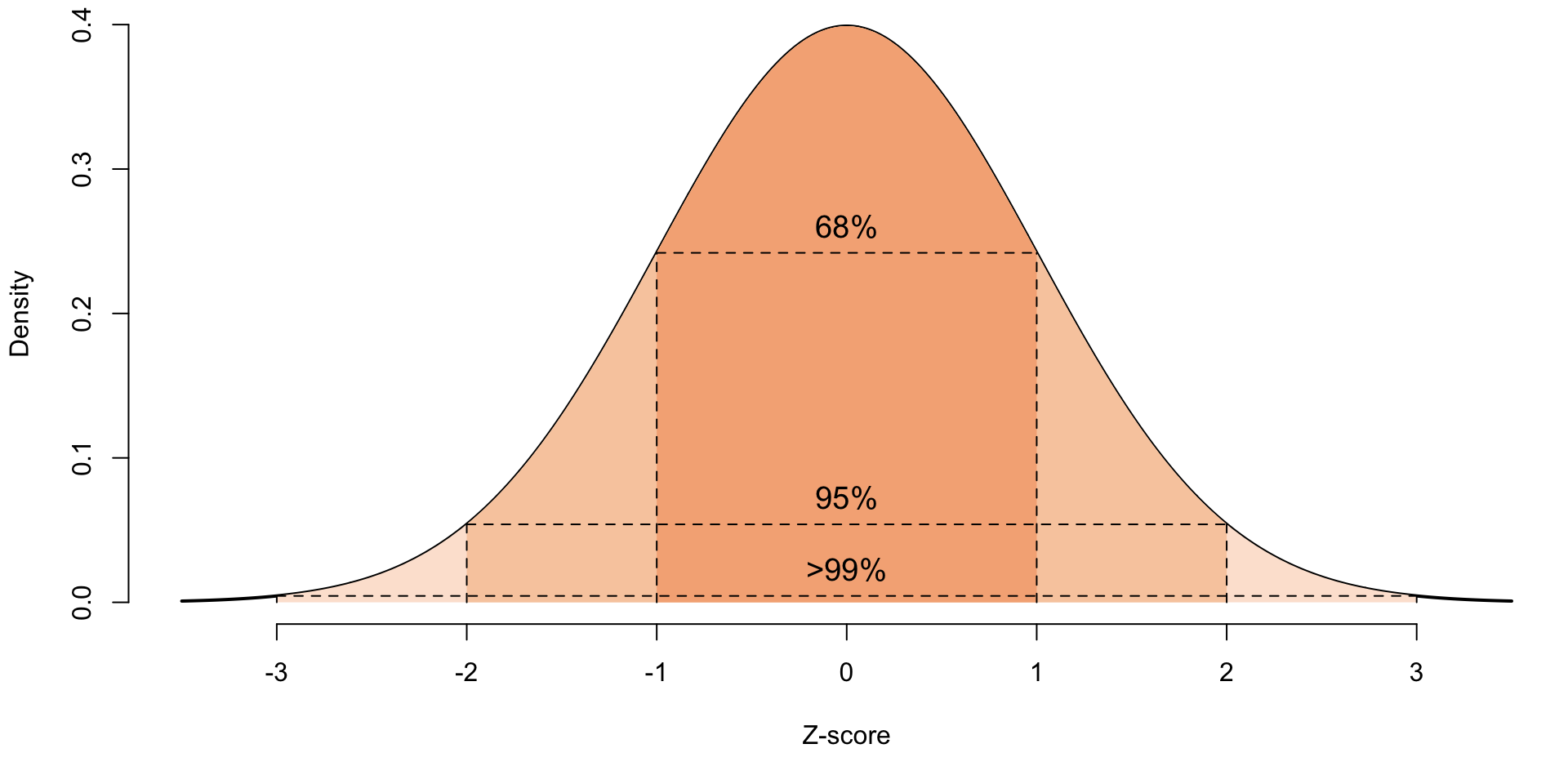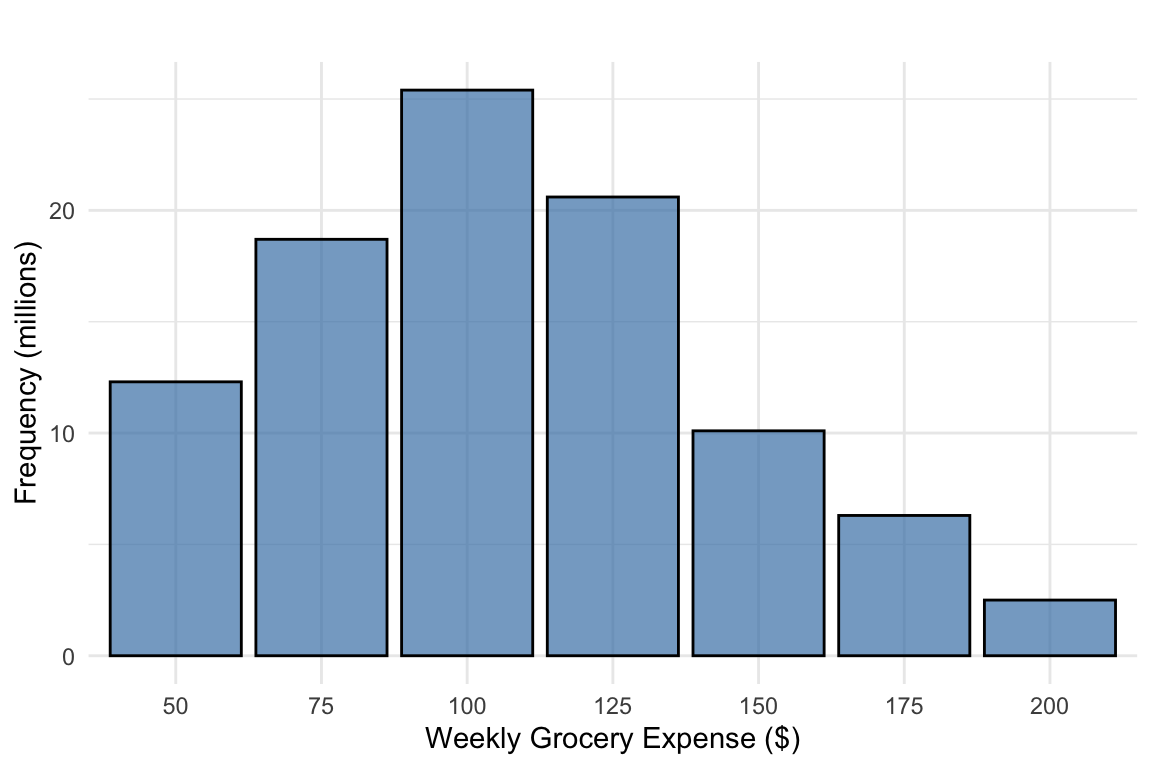Lecture 6: Sampling Distributions in Action
STAT 205: Introduction to Mathematical Statistics
University of British Columbia Okanagan
Outline
In Lecture 4 we discussed the Central Limit Theorem (CTL) and its role in approximating distributions.
- Sampling Distribution of the mean
- Sampling Distribution for Proportions
- Sampling Distribution of Variance
Today we will apply these concepts to practical examples…
Learning Outcomes
By the end of this lecture students should know:
How to apply the CLT to different types of problems.
How to use continuity corrections when approximating binomial probabilities.
How sample size affects probability estimates and why larger samples yield more accurate approximations.
How to use R and tables to compute probabilities efficiently.
Finding Probabilities
In a test1 situation, you will rely on probability tables to find probabilities. The relevant tables for this section are:
When you have access to R (e.g., in assignments), you should use R to compute your answers2.
STAT 203
Review
CLT
Central Limit Theorem
Let \(X_1, X_2, \dots, X_n\) be a RIS sample from a population with mean \(\mu\) and variance \(\sigma^2\). Then for \(n\) large:
\[ \begin{align*} X_1 + X_2 + \dots + X_n &\sim N(n\mu, n\sigma^2) & \text{Sum of Random Variables:}\\ \overline{X} &\sim N\left(\mu, \dfrac{\sigma^2}{n}\right) & \text{Sample Mean} \\ \end{align*} \]
The standardized sample mean converges in distribution to the standard normal
\[ \begin{align} Z_n = \dfrac{\overline{X} - \mu}{\sigma/\sqrt{n}} &\xrightarrow{d} N(0,1) & \text{Standardized Form} \end{align} \]
Why Standardization?
Standardization transforms any normal distribution into a standard normal1 distribution with:
- Mean \(\mu = 0\)
- Standard deviation \(\sigma = 1\)
The historical reason for standardization was that probabilities were calculated using standard normal tables.
While this is not necessary with the easy access to computers, this technique will still be useful for tests.
Standardization Formula
Given a normal variable \(X \sim \text{Normal}(\mu, \sigma)\), we compute its standardized value (\(Z\)-score):
\[ Z = \frac{X - \mu}{\sigma} \]
- \(Z\) tells us how many standard deviations \(X\) is away from the mean.
- Standardization allows us to use the standard normal table to find probabilities.
Example of Standardization
Suppose the heights of students are normally distributed with:
- Mean: \(\mu = 170\) cm
- Standard deviation: \(\sigma = 8\) cm
\[X \sim N(\mu = 170, \sigma = 8)\]
The \(Z\)-score for a student who is 180 cm tall:
\[ Z = \frac{X - \mu}{\sigma} = \frac{180 - 170}{8} = \frac{10}{8} = 1.25 \]
A height of 180 cm is 1.25 standard deviations above the mean.

Finding Probabilities Using Z-scores
To find \(\Pr(X < 180)\) we use the standard normal distribution formula:
- \(\Pr(X < 180) =\) \(\Pr\left(\dfrac{X -\mu}{\sigma} < \dfrac{180 -\mu}{\sigma}\right)\)
-
\(\phantom{\Pr(X < 180)}=\Pr\left(Z < \dfrac{180 -170}{8}\right)\)
-
\(\phantom{\Pr(X < 180)}=\Pr\left(Z < \dfrac{10}{8}\right)\)
-
\(\phantom{\Pr(X < 180)}=\Pr\left(Z < 1.25\right)\)
-
\(\phantom{\Pr(X < 180)}=\quad ?\)
At this point we can consult our Z-table
Use this table to find probabilities for
positive Z-scores!
Use this table to find
probabilities for
negative Z-scores!


Probabilities in R
Note
Notice how \(Z \sim N(0,1)\) is the default
q-
vector of quantiles
mean-
mean (default is
0) sd-
standard deviation (default is
1) lower.tail-
logical; if TRUE (default), probabilities are \(\Pr(X \leq q)\) otherwise \(\Pr(X > q)\)
pnorm for Standard Normal
For the standard normal we use the defaults
General pnorm
For some \(X \sim N(\mu = \texttt{mu}, \sigma = \texttt{sig})\)…
Visualize Probabilities
Finding Probabilities Using Z-scores
To find probabilites for \(X\sim N(\mu, \sigma)\)
-
Convert \(X\) to a \(Z\)-score:
\[ Z = \frac{x - \mu}{\sigma} = z \]
-
Use the standard normal Z-table or R
\(P(Z < z)\) pnorm(z)\(P(Z > z)\) pnorm(z, lower.tail = FALSE)\(P(a < Z < b)\) pnorm(b) - pnorm(a)
Standardizing a Sample Mean
If we take a sample of size \(n\), the mean \(\bar{X}\) follows:
\[ \bar{X} \sim \text{Normal}\left(\mu_{\bar X} = \mu, \sigma_{\bar X} = \frac{\sigma}{\sqrt{n}}\right) \]
To standardize the sample mean:
\[ Z = \frac{\bar{X} - \mu_{\bar X}}{\sigma_{\bar X}} = \frac{\bar{X} - \mu_{\bar X}}{\sigma / \sqrt{n}} \]
Household Groceries (iClicker)
Exercise 1 Weekly Grocery Expenses The weekly grocery expenses for households in a certain region follow the the distribution given in Figure 1. According to a national consumer survey, the average grocery expense for this region is 107 with a standard deviation of \(38\). A random sample of 25 households is selected from this population.
What is the sampling distribution1 of \(\bar X\)?
- \(\bar X \sim N(0,1)\)
- \(\bar X \sim N(107,38)\)
- \(\bar X \sim N(107,38/25)\)
- \(\bar X \sim N(107,38/\sqrt{25})\)
- None of the above

✏️ Household Groceries
Exercise 2 Weekly Grocery Expenses The weekly grocery expenses for households in a certain region follow the the distribution given in Figure 1. According to a national consumer survey, the average grocery expense for this region is 107 with a standard deviation of \(38\). A random sample of 25 households is selected from this population.

What is the probability that the average weekly grocery expense for a randomly selected sample of 25 households exceeds $120?
Solution
We want \(\Pr(\bar X > 120)\) where the sample mean \(\bar{X}\) follows a normal distribution:
\[ \bar{X} \sim \text{Normal}(\mu_{\bar{X}} = 107, \sigma_{\bar{X}} = \frac{\sigma}{\sqrt{n}} = \frac{38}{\sqrt{25}} = 7.6) \]
We compute the standardized Z-score:
\[ Z = \frac{\bar X - \mu}{\sigma_{\bar{X}}} = \frac{120 - 107}{7.6} = 1.711 \]
Thus, the probability that the sample mean exceeds $120 is:
\[ P(\bar{X} > 120) = P(Z > 1.711) \]
Using the \(Z\)-table:
\[ P(Z > 1.711) = 1 - P(Z < 1.711) = 1 - 0.9564 \]
Final probability:
\[ P(\bar{X} > 120) = 0.0436 \]
Summary
🔹 Although the population distribution is skewed, the CLT tells us that the sampling distribution of \(\bar{X}\) can be approximated by a normal distribution when the sample size is sufficiently large.
🔹 We stanrdarize \(\bar X\) to find probabilities on the standard normal curve.
Sampling Distribution for Proportions
CLT for proportions
When observations are independent and the sample size is sufficiently large, the sample proportion \(\hat p\) is given by
\[ \hat p = \frac{X_1 + X_2 + \dots X_n}{n} \rightarrow N\left(\mu_{\hat p} = p, \sigma_{\hat p} = \sqrt{\frac{p(1-p)}{n}}\right) \]
Success-failure condition
In order for the Central Limit Theorem to hold, the sample size is typically considered sufficiently large when \(np \geq 10\) and \(n(1-p) \geq 10\) , which is called the success-failure condition.
High School Graduation Rates in Canada (iClicker)
Exercise 3 According to the 2021 Canadian Census, 94% of Canadian adults have completed at least a high school education. Suppose a random sample of 800 Canadian adults is taken, and it is observed that 738 of them have completed high school. Which of the following is TRUE regarding population and sample proportions?
- The 94% represents the sample proportion because it comes from the Census data.
- The 94% is the population proportion, while the proportion calculated from the sample is the sample proportion.
- The sample proportion can never be smaller than the population proportion if the sample is random.
- Both 94% and the proportion calculated from the sample are considered population proportions.
High School Graduation Rates in Canada (iClicker)
Exercise 4 According to the 2021 Canadian Census, 94% of Canadian adults have completed at least a high school education. Suppose a random sample of 800 Canadian adults is taken, and it is observed that 738 of them have completed high school. Can the sampling distribution of \(\hat{p}\) be modeled as approximately normal?
No since the population proportion is too high for normal approximation to be valid.
No since we are not sampling from a normal population.
Yes since \(n > 30\)
Yes since both \(n*p\) and \(n*(1-p)\) > 10
High School Graduation Rates in Canada (iClicker)
Exercise 5 According to the 2021 Canadian Census, 94% of Canadian adults have completed at least a high school education. Suppose a random sample of 800 Canadian adults is taken, and it is observed that 738 of them have completed high school. What is the standard error of the sample proportion?
\(\dfrac{0.94(1-0.94)}{\sqrt{800}}\)
\(\sqrt{\dfrac{0.94(1-0.94)}{800}}\)
\(\sqrt{\dfrac{0.94(1-0.94)}{800}}\)
\(\sqrt{\dfrac{\frac{738}{800}(1-\frac{738}{800})}{800}}\)
High School Graduation Rates in Canada
Exercise 6 According to the 2021 Canadian Census, 94% of Canadian adults have completed at least a high school education. The 2016 Canadian Census reported that 81.7% of Canadian adults have a secondary or equivalent degree. What is the probability that the sample proportion from the 2021 population will be as small or smaller than 81.7%?
Solution
Sampling Distribution of Variance
Sampling Distribution of Variance
Let \(X_1, X_2, \dots, X_n\) be a random sample from a normal population with mean \(\mu\) and variance \(\sigma^2\). It can be shown that
\[\begin{align*} \dfrac{(n−1)S^2}{\sigma^2} \sim \chi^2_{(n-1)} \end{align*}\]
where \(\chi^2_{(n-1)}\) denotes a chi-squared distribution with \(n−1\) degrees of freedom.
Probability for the Sampling Distribution of \(S^2\)
Exercise 7 A study reports that the variance in weekly grocery expenses for Canadian households is \(\sigma^2=225\) dollars squared. Suppose a random sample of 15 households is taken, and their sample variance \(S^2\) is computed. What is the probability that the sample variance is greater than 275?
\(P(S^2 > 275) = P\left(\chi^2 > \frac{n \times 275}{\sigma^2}\right)\)
\(P(S^2 > 275) = P\left(\chi^2 < \frac{n \times 275}{\sigma^2}\right)\)
\(P(S^2 > 275) = P\left(\chi^2 > \frac{(n-1) \times 275}{\sigma^2}\right)\)
\(P(S^2 > 275) = P\left(\chi^2 < \frac{(n-1) \times 275}{\sigma^2}\right)\)
Probabilities for Chi-squared RV
Compute the Chi-Square Test Statistic1
\[\chi^2=\frac{(n-1)s^2}{\sigma^2}=\frac{(15-1)\times 275}{275}=\frac{14\times 275}{275}\]
To find the probability we need the Chi-squared table or R
\[P(S^2 > 275) = P(\chi^2 > 17.111)\]

\[ \begin{align} \phantom{x}\\ \phantom{x}\\ \phantom{x}\\ \end{align} \]
Note
The Chi-squared table gives upper tail probabilities.



\[ \begin{align} P(S^2 > 275) = &P(\chi^2 > 17.111)\\ \Pr(\chi^2 > 21.064) < &P(\chi^2 > 17.111) < \Pr(\chi^2 > 7.790) \\ .10 < &P(\chi^2 > 17.111) < .90 \\ \end{align} \]
Chisquared Visualized

Chisquared Visualized

Chisquared Visualized

Hence the \(\Pr(\chi^2_{14} > 17.1)\) should be bigger than 10% but smaller than 90%.
Chisquared probabilities in R
q-
vector of quantiles
df-
degrees of freedom
lower.tail-
logical; if TRUE (default), probabilities are \(\Pr(X \leq q)\) otherwise \(\Pr(X > q)\)
Solution
To find the probability:
\[P(S^2 > 275) = P(\chi^2 > 17.111)\]
Using R:
[1] 0.2503109\[P(S^2 > 275) = 0.2503\]
Thus, the probability that the sample variance \(S^2\) exceeds 275 is 0.2503.





